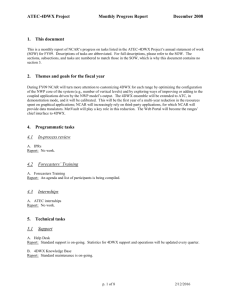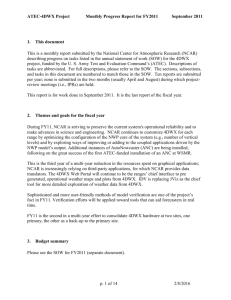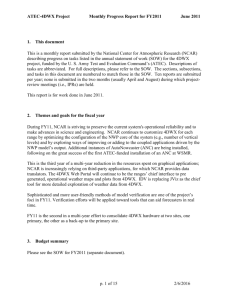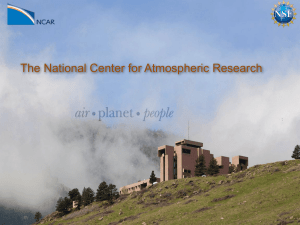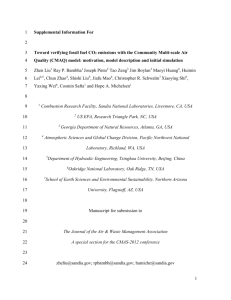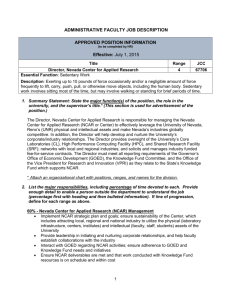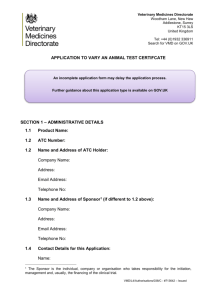4DWX Database
advertisement
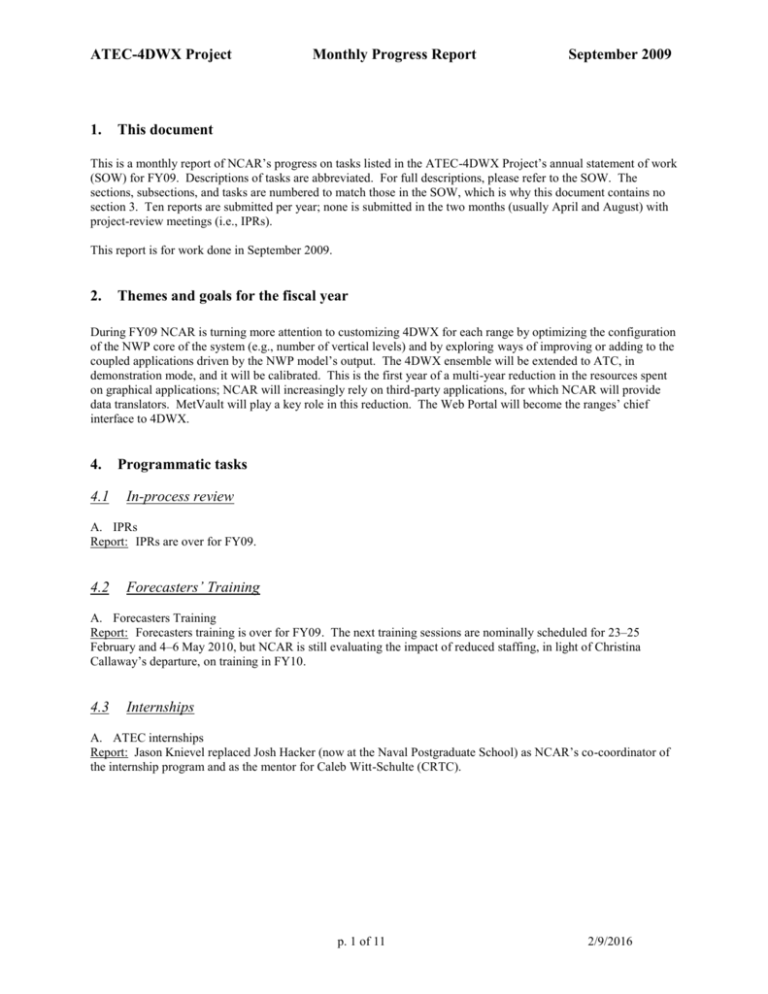
ATEC-4DWX Project 1. Monthly Progress Report September 2009 This document This is a monthly report of NCAR’s progress on tasks listed in the ATEC-4DWX Project’s annual statement of work (SOW) for FY09. Descriptions of tasks are abbreviated. For full descriptions, please refer to the SOW. The sections, subsections, and tasks are numbered to match those in the SOW, which is why this document contains no section 3. Ten reports are submitted per year; none is submitted in the two months (usually April and August) with project-review meetings (i.e., IPRs). This report is for work done in September 2009. 2. Themes and goals for the fiscal year During FY09 NCAR is turning more attention to customizing 4DWX for each range by optimizing the configuration of the NWP core of the system (e.g., number of vertical levels) and by exploring ways of improving or adding to the coupled applications driven by the NWP model’s output. The 4DWX ensemble will be extended to ATC, in demonstration mode, and it will be calibrated. This is the first year of a multi-year reduction in the resources spent on graphical applications; NCAR will increasingly rely on third-party applications, for which NCAR will provide data translators. MetVault will play a key role in this reduction. The Web Portal will become the ranges’ chief interface to 4DWX. 4. Programmatic tasks 4.1 In-process review A. IPRs Report: IPRs are over for FY09. 4.2 Forecasters’ Training A. Forecasters Training Report: Forecasters training is over for FY09. The next training sessions are nominally scheduled for 23–25 February and 4–6 May 2010, but NCAR is still evaluating the impact of reduced staffing, in light of Christina Callaway’s departure, on training in FY10. 4.3 Internships A. ATEC internships Report: Jason Knievel replaced Josh Hacker (now at the Naval Postgraduate School) as NCAR’s co-coordinator of the internship program and as the mentor for Caleb Witt-Schulte (CRTC). p. 1 of 11 2/9/2016 ATEC-4DWX Project 5. 5.1 Monthly Progress Report September 2009 Technical tasks Support A. Help Desk Report: Standard support is ongoing. There was considerable effort this month in juggling a high number of simultaneous safari missions at the time that older cluster hardware at NCAR was failing. The result of this was that all the safaris were just barely supported and several ranges had their backup MM5 runs turned off for an indefinite period. B. 4DWX Knowledge Base Report: Standard maintenance and addition of material is ongoing. C. Teleconferences with each range Report: Teleconferences with ranges—collectively and rotated individually—are being held regularly. Over the last three months, these were convened: July: 1st – EPG 8th – ATC 15th – CRTC 22nd – DPG August: 5th – all ranges September: 2nd – all ranges 9th – DPG 16th – YPG Note: The frequency of range telecons beginning in October may be reduced due Christina Callaway’s departure at the end of September. We will continue the monthly all-range telecons at a minimum. 5.2 Customization of 4DWX for each range A. Simulated soundings for WSMR Report: No work. B. Gridded bias correction of WRF model Report: All prototyping work is completed. Now the code is being ported to the operational environment for planned deployment as part of the upgrade to WRF v3.1. Then first implementation will be for WSMR. Full support for the bias corrected displays in the Web Portal is anticipated no later than end of January 2010. C. Polar WRF model Report: No work. D. Enhance WRF model physics for CRTC Report: See 5.2.C above. E. Cold-air damming’s (CAD’s) local effects at ATC Report: A manuscript is being prepared for peer-reviewed publication. F. Improved forecasts of gravity waves at WSMR Report: No work. p. 2 of 11 2/9/2016 ATEC-4DWX Project Monthly Progress Report September 2009 G. E-RTFDDA output for CMAQ at UDAQ Report: No work. H. Surface snow cover and depth downscaling scheme for DPG and CRTC Report: We are re-activating this effort as winter approaches. We are in the process of bringing in a land-surface expert to continue and complete this work. I. Three-dimensional sound ray-tracing package Report: No work. J. Derivation of Cn2 from 4DWX output Report: NCAR received reviews of our manuscript. We are running an additional set of simulations, based on a reviewer’s request to see not only analyses from 4DWX, but also forecasts. Pending those, and a few more minor changes, we expect a revised manuscript to be accepted later this year. K. Sensitivity of NAPS to parameterizations in the WRF model Report: No work. L. Alternatives to NAPS Report: No work. 5.3 User applications A. Graphical tool for viewing 4DWX’s verification statistics Report: Gridded bias correction (see 5.2.B) has temporarily been given priority over this task. We expect to return to this task in early FY10. B. Object-oriented verification of precipitation Report: No work. C. Verification of 4DWX mesoscale ensemble Report: No work. D. Operational forecast aids Report: No work. E. MetVault Report: No work. F. 4DWX Web Portal Report: Work is ongoing for the DAS v3.3 release, planned for end of October. G. GMOD Report: No work. H. MIR Report: Work is ongoing for the DAS v3.3 release, planned for end of October. I. Maintenance of JViz and plan for retirement Report: Work is ongoing for replacing JViz with IDV. Development work is currently focused on selection and display of observations and model data in IDV. p. 3 of 11 2/9/2016 ATEC-4DWX Project 5.4 Monthly Progress Report September 2009 NWP modeling A. Upgrade to WRF Model v3 Report: We found further issues with the adaptive time step in the community release of WRFV3.1. We applied a temporary fix but do not yet understand the full scope of the problem, because it appears to be machine dependent. The broader WRF user community has reported various concerns with this scheme. The adaptive time step is new in the model and it typically speeds up computing by 25% or more. It can also potentially increase model accuracy, although more study of this potential is needed. Therefore it is economically and technically valuable for ATEC, which runs many operational systems. Further tests and study with CRTC systems will be conducted. It will be updated into operational systems as soon as it can be stabilized. Once this is done, we can consider upgrading 4DWX to the more sophisticated and costly microphysics schemes available in the WRF Model, including Morrison and Thompsons schemes. The schedule for upgrade to WRF3.1 is better defined. DPG, ATC, WSMR, and YPG will be done in the first half of November. On the top of the basic WRFV3.1 RTFDDA code, two extra refinements are being made. First, there is a need to reduce the WRF Model compilation optimization. This will slow the model slightly, but will avoid some optimization-related noise than can contaminate the model forecasts during parallel processing. Second, we fixed a minor bug in the WRF preprocessor that deals with the 3 extra land-soil types in the ATEC model domains. B. Refine nudging scheme in RTFDDA Report: We continue to evaluate and refine the surface-data observation-nudging weighting according to PBL stability regimes and temporal variations. We designed a data-assimilation localization scheme based on observation density. We’ll start to implement it soon. C. Hybrid data-assimilation scheme Report: ATC is selected as a testbed. We are in the process of developing data ingest and data processing, including data QC and de-aliasing radial wind folders for 5 WSR-88D radars using the VDRAS pre-processing module. We are setting up a an RTFDDA-hybrid test system on a research cluster, which will provide WRF fields to support radar data QC, and later will be able run with radar data assimilation. D. Calibration of 30-member ensemble Report: We are still working on improving calibration efficiency, which is a necessary step before full operational implementation. Memory and I/O are demands are low, but CPU demands are very high. E. Demonstration ensemble for ATC Report: No work. F. Dynamical selection of potential ensemble members Report: No work. G. Ensemble of global models to prescribe initial and boundary conditions for 4DWX ensemble Report: No work. H. General improvements to E-4DWX perturbation schemes. Report: We continue to evaluate the difference between the new MODIS-based land use specifications and the standard USGS land use specifications. We are in the process of upgrading the E-4DWX WRF member to WRFV3.1, including all bug fixes and advances described in 5.4A. The upgrade will also include an integration of high-resolution SST (1/12 degree from NCEP) which will provide better SST for the Great Salt Lake across all members. This upgrade is an interim step before a MODIS-based SST composite is applied later this FY. I. MODIS SSTs in 4DWX system Report: Based on results of internal reviews, we are revising the manuscript to be submitted to the Journal of Applied Meteorology and Climatology in October. Work has begun on applying the MODIS-based algorithms to the Great Salt Lake for implementation in DPG’s 4DWX in FY10. First steps have involved communicating with Erik Crosman at University of Utah, who has already published work on using MODIS data to improve p. 4 of 11 2/9/2016 ATEC-4DWX Project Monthly Progress Report September 2009 climatographies of the GSL. He has been very helpful in pointing us to in-situ observations of lake temperature that can be used for verification. J. Other general improvements to 4DWX Report: We continue to test NCAR DART, an ensemble-based Kalman filter data-assimilation tool. A test run with off-line DART data assimilation along with RTFDDA has been conducted using the ATC CAD case, which has provided some valuable understanding. This work is leveraging several other NCAR projects. 5.5 Auto-Nowcaster and convective weather forecasting A. RTTC’s use of LMA data from UAH Report: Completed. B. ANC at EPG or RTTC Report: A cost quote was received for the new Linux machine to be installed at RTTC. Discussions regarding LDM access to the LMA and Armor radar datasets have been held with Scott Padgonry. C. Short-term lightning potential forecasts at EPG Report: No work needed. D. VLAS at DPG Report: This task is closed because the CTI lidar will not be operational in the foreseeable future, and there is no need for the VLAS installation. E. VDRAS and ANC at DPG Report: Cathy Kessinger visited DPG on 10 September to collect preliminary data from the new C-band and Xband radars. The data were brought back in three formats: Edge, NEXRAD and Universal Format (UF). The UF format files were successfully read and the data displayed. Software to read the Edge format files exists at NCAR and will be used to read these files, too. The old VLAS computer is now on the network and we are able to login remotely. F. Long-term probabilistic forecasts of lightning at WSMR Report: No progress on the RTFDDA forecasts for lightning. However, processing of the NLDN climatographies nears completion. They will be ready for installation at the ranges in October. G. Refined ANC forecast logic at WSMR Report: Because of the ANC domain expansion, using the 4DWX domain 2 model results provides better coverage. At the IPR in August, WSMR requested that 4DWX be run out to a 72-h lead time with updates four times daily. This has necessitated a change in our procedures to calculate the model stability analysis and we are investigating the best way to proceed. Testing of the LMA flash data and its rate of change for inclusion within the AutoNowcaster is underway. Approximately two weeks of data from the summer of 2008 are included in this test. An upgrade to the boundary-entry software was completed in September. At the IPR in August, Ed Ellison was instructed on how to enter boundaries, but he has had trouble doing so from WSMR. We are investigating further software issues. A MADIS real-time data feed has been enabled for WSMR. Configuration for NOAAport is to be done by Scott Halvorson. The executable Gini2Mdv (converts NOAA satellite imagery into NCAR Mdv format) was identified as being out of date since the water-vapor-channel calibration was refigured some time ago. This executable will be updated during the October code updates for all ranges. A new growth-and-decay parameter file was installed for the RTFDDA stability analysis and the LMA variables, and is producing 30-min forecasts. This new parameter file is running in parallel with the operational system to enable testing without affecting the operational system. p. 5 of 11 2/9/2016 ATEC-4DWX Project Monthly Progress Report September 2009 H. Upgrade of VDRAS at WSMR Report: Completed. I. AP ground clutter removal at WSMR Report: Completed. J. Operational support for the ANC and ANC-Lite Report: During Cathy Kessinger’s visit to DPG, a forecaster mentioned that the performance of the MRRD storm extrapolation was inadequate. Upon investigation, it was found that the methodology in use was due for an upgrade. After the next storm at DPG, radar data were retrieved and an improved tuning of the TITAN (storm tracker) parameter files were accomplished and installed. A second, and final, upgrade will be done to merge the RTFDDA model wind fields with the TITAN storm motion vectors and to apply temporal and spatial filters. These upgrades will improve the extrapolation vectors realized for both new and existing storms. This full upgrade will occur in October at all the ranges (during the scheduled software upgrade) with considerably improved performance expected. Data were retrieved from the MRRD systems at the EPG, YPG, RTTC, and ATC ranges for testing this upgrade. 5.6 Tasks funded through other sources but leveraged to benefit ATEC-4DWX project A. STAR Institute’s CFDDA climatographies for the ATEC ranges Report: STAR's contract with MSU to perform CFDDA climatographies has ended. After several failures of the HPC and account access problems, STAR is in the process of attempting to retrieve the large DPG climate dataset for further post-processing and transfer to DPG. STAR is also planning to bid on follow-on work to complete the other ranges and develop a climate query tool. 5.7 Hardware, operating systems, and security A. Data storage Report: No recent purchases. B. New office computers for project staff Report: Standard replacement of old computers is ongoing. Several staff computers are more than 5 years old, and long out of warranty, so NCAR expects to replace these soon. C. GPU and/or cell technology Report: No work. D. Consolidation of 4DWX model runs Report: Evaluation of “next gen” hardware and software options for the consolidated MACs continues. The current focus is on evaluating different interconnect technologies and accompanying software. Dell recently announced more powerful blade hardware to be available Feb 2010, which is very promising. Prices have not been announced. E. Operating systems Report: Routine maintenance continues. F. Security Report: We are addressing the Army “Whitelist” policies that closed the ports used by 4DWX Web pages at all ranges. Outside access to the 4DWX Web pages is working only for EPG and DPG, but Scott Halvorson has reported that RTTC will be ready soon. YPG and CRTC are in progress, and ATC still requires a solution for a reverse proxy issue. G. Clusters p. 6 of 11 2/9/2016 ATEC-4DWX Project Monthly Progress Report September 2009 Report: R&D clusters smac-c2 and smac-c3 are running multiple instances of 4DWX, some for R&D, some for operational support (e.g., safari missions for NVL). The old clusters gs-c2 and gs-c3 continue to break down, so one of them will likely be shut down permanently in the near future. NCAR is studying whether a small cluster from a different project, which will be ending in several months, might be acquired for the ATEC-4DWX project. Operating systems on smac-c2 and smac-c3 are undergoing major upgrades to accommodate increased security and bug fixes. Methods of installing and maintaining supporting software are also being revised to streamline operational installations; this is an important step in increasing the efficiency of operational support and technology transfer. This work will be finished in October or November with minimal interruption to R&D and operations. 5.8 Management A. NCAR’s project management Report: No change. 5.9 Administration and miscellany A. Proposal to use MSRC facilities to run a very large ensemble Report: No work. B. Articles, posters, and talks Report: The following were submitted for internal or external review, presented, accepted for publication, or published during the last month: Knievel, J. C., D. L. Rife, J. A. Grim, A. N. Hahmann, J. P. Hacker, M. Ge, and H. H. Fisher, 2010: A simple technique for creating composite lake- and sea-surface temperatures from MODIS for use in NWP. J. Appl. Meteorol. Clim., in revision based on internal review. Liu, Y., J. C. Knievel, S. F. Halvorson, J. C. Pace, G. Roux, W. Wu, J. P. Hacker, T. M. Hopson, S. E. Krippner, T. T. Warner, and S. P. Swerdlin, 2010: Mesoscale ensemble weather prediction at Dugway Proving Ground. J. of the ITEA, in preparation. (At the August IPR, Michael Barton recommended that we submit to this journal.) p. 7 of 11 2/9/2016 ATEC-4DWX Project Monthly Progress Report September 2009 APPENDICES A. Acronyms 4DWX 4DWXDB AGU AMS AP ATEC ATC AUSA CAC CAD CFDDA CIDD CMAQ COAMPS COLIDE CoN CRTC CVS DART DAS DPG EPG ERTFDDA GMOD GPU HPC HPCMP IPR KB LMA MIR MIPR MODIS MODTRAN MSFC MSRC MYJ scheme NAPS NASA NCAR NCEP NLDN NRL NSAP NSF NVL NWP PBL R&D RAL Four-Dimensional Data Assimilation and Forecast System 4DWX database American Geophysical Union American Meteorological Society Anomalous propagation U.S. Army Test and Evaluation Command Aberdeen Test Center Association of the U. S. Army Common Access Card Cold-air damming Climate FDDA Configurable Interactive Data Display Community Multiscale Air Quality Model Coupled Ocean/Atmosphere Mesoscale Prediction System Convergent Line Detection program Certificate of Networthiness Cold Regions Test Center Concurrent Versioning System Data Assimilation Research Testbed Data Acquisition Server Dugway Proving Ground Electronics Proving Ground Ensemble-RTFDDA Global Meteorology on Demand Game processing unit High performance computer HPC Modernization Program In-process review Knowledge Base Lightning mapping array Meteorological Information Repository Military Interdepartmental Procurement Request Moderate Resolution Imaging Spectroradiometer Moderate resolution atmospheric transmission Marshall Space Flight Center Major Shared Resource Center Mellor-Yamada-Janjic Noise Assessment and Prediction System National Aeronautics and Space Administration National Center for Atmospheric Research National Centers for Environmental Prediction National Lightning Detection Network Naval Research Laboratory National Security Applications Program (within NCAR RAL) National Science Foundation Night Vision Laboratory Numerical weather prediction Planetary boundary layer Research and development Research Applications Laboratory p. 8 of 11 2/9/2016 ATEC-4DWX Project RTFDDA RTTC SST STAR Inst. STEP UAH UF USWRP VLAS VDRAS WRF model WSMR YPG YSU Monthly Progress Report September 2009 Real-Time Four-Dimensional Data Assimilations system Redstone Technical Test Center Sea-surface temperature Science and Technology in Atmospheric Research Institute Short-Term Explicit Prediction University of Alabama at Huntsville Universal format U.S. Weather Research Program Variational Lidar Analysis System Variational Doppler Radar Analysis System Weather Research and Forecasting Model White Sands Missile Range Yuma Proving Ground Yonsei University p. 9 of 11 2/9/2016 ATEC-4DWX Project Monthly Progress Report September 2009 B. Detailed milestones of selected tasks Development of hybrid data assimilation Our plan is for implementation of hybrid radar data assimilation in FY10. Tasks and target dates for a real-time test at ATC follow: Establish real-time Level 2 radar data feed for radars in ATC domain Installation of VDRAS preprocessing RTFDDA hybrid system coding for operations ATC case studies and scientific evaluation Software and system optimization Real-time testing and evaluation Operational upgrade p. 10 of 11 2009/10 2009/11 2009/12 2009/12–2010/04 2010/05 2010/06–08 2010/08–09 2/9/2016 ATEC-4DWX Project Monthly Progress Report September 2009 C. Safari missions The current standing requests for 4DWX support of safari missions (i.e., missions of range) are listed below. Requester: RTTC Dates: May 18 until all rockets are fired (2/3 completed as of this report) Location: Red River Arsenal Type: WRF with 3 domains Requester: NVL Dates: Was July 1 through July 31; turned off on 9 September Location: Fort AP Hill Type: WRF with 4 domains Requester: WSMR Dates: September 21 through October 17 Location: Fort Wingate Type: WRF with 3 domains Requester: WSMR Dates: September 23 through November 10 Location: PMRF Type: WRF with 4 domains Requester: NVL Dates: October 5 through November 25 Location: Baumholder, Germany Type: WRF with 4 domains When using the Lewis model at PMRF during a recent safari mission, forecasters from WSMR indicated they thought there was an error in the code that involved the sign convention for the winds. NCAR has reviewed the code. No error is immediately apparent. We continue to discuss the issue with WSMR and plan to conduct a comparison run using GEM. p. 11 of 11 2/9/2016
